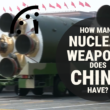The logic for space arms control
By Nancy Gallagher, July 30, 2015
In Round Three, Wu Chunsi argued that arms control proposals should fit current security circumstances and that ideas based on Cold War logic are not appropriate today. I agree that an important objective of strategic dialogue should be finding forms of cooperation that address whatever risks and opportunities each nation believes may come from developing, testing, and using space technologies that have both legitimate and potentially threatening applications. But must such a discussion start from scratch? The circumstances and concerns that shaped Cold War arms control remain more relevant than most people realize, and can be incorporated into a logic for space arms control in the 21st century.
Wu oversimplified the circumstances shaping Cold War arms control: Two roughly equal powers, enjoying easy communication and possessing accurate information about each other's preferences, struck bilateral bargains. But many negotiations, including those for the Outer Space Treaty and Nuclear Non-Proliferation Treaty, were multilateral. Mistrust, miscommunication, secrecy, and diplomatic discretion kept the superpowers guessing about each other’s intentions. And long after the Soviet Union had achieved nuclear "parity" with the United States, policy makers still debated the importance of real or imagined asymmetries between their current or future capabilities.
Same risk. Bharath Gopalaswamy, meanwhile, to support his claim that antisatellite weapons do not increase the risk of nuclear war—and that antisatellite arms control is unnecessary—assessed in Round Two a security scenario that sounds like a recycled version of a scenario used by arms control opponents in the 1970s. Back then, groups such as the Committee on the Present Danger portrayed the Soviet Union as increasingly powerful, aggressive, and likely to launch a nuclear first strike if it had any chance of avoiding devastating retaliation. In Gopalaswamy's scenario, China replaces the Soviet Union. Though Gopalaswamy ultimately argued that China’s increased counterspace capabilities may well present little cause for alarm, he missed this point: that Chinese leaders today—with or without antisatellite weapons or a no-first use policy—are no more likely than were Soviet leaders to believe that a deliberate nuclear attack on the United States or its allies is rational.
Indeed, the main cause for concern about space and strategic stability today is the same risk that the Outer Space Treaty tried to address: When war seems imminent, and if the parties possess the technical capability to place weapons in space or destroy satellites used for early warning, reconnaissance, or communication, then incentives for preemptive attack on space assets increase. Using antisatellite weapons in the opening round of a conflict could produce a war that neither side wanted, while also reducing the effectiveness of command, control, communication, and intelligence assets needed for skillful crisis management, escalation control, and war termination.
Give and take. Wu and Gopalaswamy have both emphasized that rules for space security must be fair to space newcomers. Indeed, the Outer Space Treaty and related space security agreements were not negotiated solely to enhance bilateral strategic stability—they were also explicitly designed to help states and non-state actors use space for a wide array of peaceful purposes without facing discrimination or inadvertently interfering with others’ use of space.
A clear need exists for in-depth discussion about the threats and opportunities that nations perceive in space, and about cooperative arrangements they would consider equitable and mutually beneficial. For example, when Gopalaswamy writes that "Indian policy managers seem highly cognizant of the hazards surrounding hard-kill weapons in space," is he referring only to the debris generated by testing (or using) dedicated hard-kill antisatellite weapons? Or does he also recognize the dangers in developing missile defense components that could be adapted for antisatellite use? Chinese experts, meanwhile, often argue that the way to reduce nuclear risk is for nuclear-armed countries to maintain no-first-use policies. But in return for a US declaration that the sole purpose of Washington's nuclear weapons is to deter nuclear attack, how might Beijing address US concerns about Chinese use of antisatellite weapons?
Such discussions should differ in important ways from those that led to the Outer Space Treaty. As drafters of the treaty anticipated, technology has advanced and the number of state and non-state actors using space for various purposes has grown. The objectives of space cooperation should also be broader now than then, focusing not only on enhancing deterrence stability but also on preventing new challenges, such as space debris and global warming, from becoming more serious problems. Rather than using straw-man arguments to reject the relevance of earlier arms control theory and practice, we should combine old and new ideas to find the best fit for today.
Topics: Nuclear Weapons, Technology and Security
Share: [addthis tool="addthis_inline_share_toolbox"]














